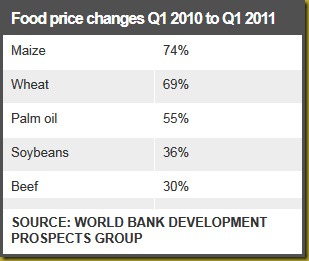Worldwide Food Prices Skyrocketing

This might not sound like that much, but when you consider the average increase over the 25 years up to 2007 was around 3.4 percent per annum then it starts to look like something might be going wrong somewhere.
There are actually three things that are not going exactly to plan.
Firstly there is the increasing cost of crude oil. A year ago crude was around $70 a barrel and it is now over $100.
Crude oil is used in just about every stage of the production, harvesting, preparation, transportation, storage, and marketing of all foods. In our modern world there is no commercially produced food that does not depend on crude.

Unfortunately the general view of the market experts is that crude is unlikely to ever go below $100 per barrel again; it is currently $109 a barrel for ‘regular’ crude and $122 for the ‘good’ stuff (Brent Crude Oil).

Over the last 20 months there have been significant stock and crop loses in almost every country due to viruses/sickness, storms, droughts, or other severe weather events. Countries impacted include India, Russia, China, the USA, and Australia (where wheat yields for 2010 were 8 percent down and 2011 forecasts are for a similar depressed yield).
I should also just add that corn crop yields, and many other crop yields (such as almonds), in the USA are also being impacted non-trivially by the lack of pollinating bees. There is a six page (PDF format) paper titled “The Case of the Missing Bees” here if anyone wants to read some more about this.
All this in a world needing more food, not less.
Thirdly the fish stocks in the oceans have fallen alarmingly over the last 30 years. This is mainly because the fewer fish there are then the slower they can breed back up. So the more we fish out the fish stocks then the slower the fish stocks can rebuild. It becomes a sort of cancer. Humans need to take more fish as the population of the planet grows, but the more we take the slower the remaining fish can restore numbers.
There is also a growing view that global warming is making things worse by impacting fish stock rebuilding. This could be due to:
- oxygen depletion (as the relative amount of carbon dioxide in the water goes up), or
- the increased acidification of the oceans (as they absorb carbon dioxide), or
- the increased water temperature, or
- a combination of all three.

Each year we need to catch about 100 million tonnes of fish to feed the world. That works out to about 274,000 tonnes of fish per day being pulled from the oceans. If the average fish pulled is 8 kilograms [which is just a number I made up because I could not find the actual fish count in the searches I did] then that would mean 34,000,000 (34 million) fish have to be pulled up every day to feed the world (well, those that want fish anyway).
The chart above shows the United Nations Food and Agriculture Organisation’s “Food Price Index” up to Q1 of 2011 starting from 1990. Interestingly the cost of food actually went down for a little while from 1998 to around mid-2002. I wonder why that was? Anyway, to find out more about this index click on the chart [use Ctrl+Click to open the Food Price Index site in a new Tab, or use Shift+Click if you are using the Opera Web browser].
I guess the bottom line here is the we shouldn’t expect the cost of food to come down any time soon, and in fact—based on the evidence available—if it doesn’t go up by another 10 to 15 percent over the next twelve months it will be a miracle.


